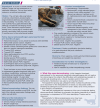Feline enteropathogens and molecular diagnostics: benefits, limitations and clinical applications
- PMID: 40776806
- PMCID: PMC12334837
- DOI: 10.1177/1098612X251352746
Feline enteropathogens and molecular diagnostics: benefits, limitations and clinical applications
Abstract
Practical relevanceFeline enteric disease is a commonly encountered presentation in clinical practice. Interpretation of the clinical relevance of enteropathogens is often misunderstood and can lead to inappropriate case management or overtreatment.Clinical challengesThe approaches to enteric disease, and the enteropathogens responsible, have proven to be an ever-emerging and challenging area within feline medicine. There are often many difficulties regarding diagnosis, interpretation of results and indications to treat. It is important to understand the aetiopathogenesis of disease, population predispositions and the principles underlying diagnostic testing, including its benefits and limitations, to appropriately manage these cases in clinical practice. Diagnostic testing and treatment should be carried out in a targeted manner only where indicated to do so.Evidence baseThis review provides extensive summaries of the most pertinent feline enteropathogens and diagnostic methods available, as well as their limitations, with a particular focus on molecular testing. The authors have provided their substantiated opinion on how best to approach these cases.Global importanceAn enhanced understanding of feline enteric disease is required not only for improved management of these veterinary patients but also particularly relates to the critical topic of antibiotic stewardship and judicious use of antibiotics, which form the mainstay of treatment for many enteropathogens, but are often used inappropriately in healthy cats testing positive for organisms that are not implicated in enteric disease.AudienceThe target audience for this review encompasses general and specialist practitioners, alongside researchers within this field.
Keywords: Enteropathogens; PCR; intestinal disease; molecular diagnostics; molecular testing.
Conflict of interest statement
Conflict of interestThe authors declared no potential conflicts of interest with respect to the research, authorship, and/or publication of this article.
Figures










Similar articles
-
Interventions to improve safe and effective medicines use by consumers: an overview of systematic reviews.Cochrane Database Syst Rev. 2014 Apr 29;2014(4):CD007768. doi: 10.1002/14651858.CD007768.pub3. Cochrane Database Syst Rev. 2014. PMID: 24777444 Free PMC article.
-
Osteoarthritis in cats: what we know, and mostly, what we don't know. . . yet.J Feline Med Surg. 2025 Jul;27(7):1098612X251347999. doi: 10.1177/1098612X251347999. Epub 2025 Jul 20. J Feline Med Surg. 2025. PMID: 40685570 Free PMC article. Review.
-
Sexual Harassment and Prevention Training.2024 Mar 29. In: StatPearls [Internet]. Treasure Island (FL): StatPearls Publishing; 2025 Jan–. 2024 Mar 29. In: StatPearls [Internet]. Treasure Island (FL): StatPearls Publishing; 2025 Jan–. PMID: 36508513 Free Books & Documents.
-
Assessing the comparative effects of interventions in COPD: a tutorial on network meta-analysis for clinicians.Respir Res. 2024 Dec 21;25(1):438. doi: 10.1186/s12931-024-03056-x. Respir Res. 2024. PMID: 39709425 Free PMC article. Review.
-
AGA Clinical Practice Update on GI Manifestations and Autonomic or Immune Dysfunction in Hypermobile Ehlers-Danlos Syndrome: Expert Review.Clin Gastroenterol Hepatol. 2025 Jul;23(8):1291-1302. doi: 10.1016/j.cgh.2025.02.015. Epub 2025 May 19. Clin Gastroenterol Hepatol. 2025. PMID: 40387691 Review.
References
-
- Hill SL, Cheney JM, Taton-Allen GF, et al. Prevalence of enteric zoonotic organisms in cats. J Am Vet Med Assoc 2000; 216: 687–692. - PubMed
-
- Queen EV, Marks SL, Farver TB. Prevalence of selected bacterial and parasitic agents in feces from diarrheic and healthy control cats from northern California. J Vet Intern Med 2012; 26: 54–60. - PubMed
Publication types
MeSH terms
Substances
LinkOut - more resources
Full Text Sources
Miscellaneous

